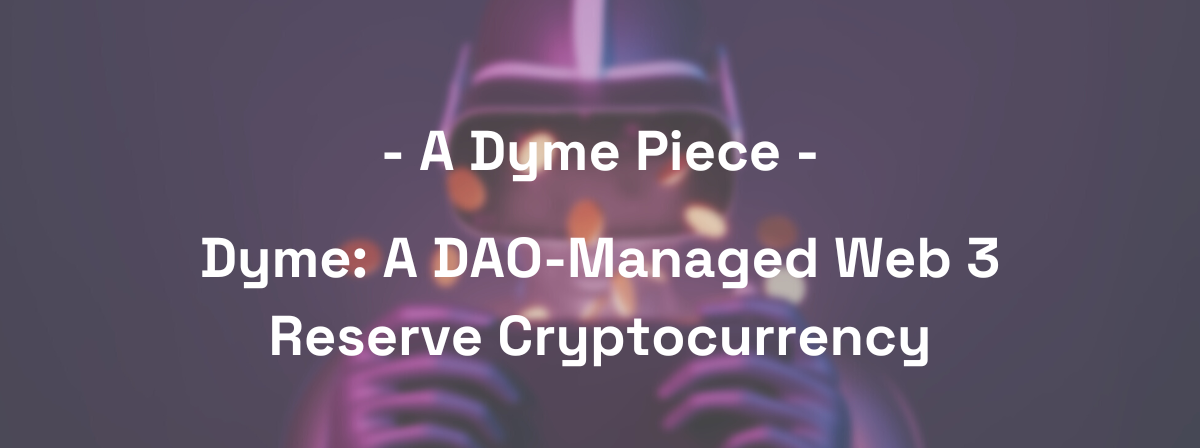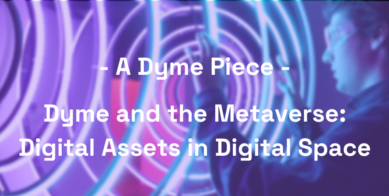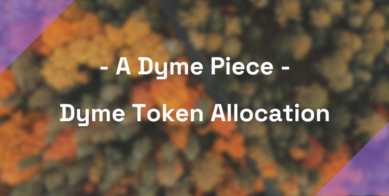Web 3, a term coined by Ethereum co-founder Gavin Wood in 2014, addresses the imbalance in economic participation, data security, privacy, and information ownership currently centralized around a small group of “Big Tech” companies. Dyme is a cryptocurrency that helps Web 3 projects solve exceedingly common and complex economic, financial, and governance challenges. These challenges limit the interoperability of Web 3, which stifles adoption and growth.
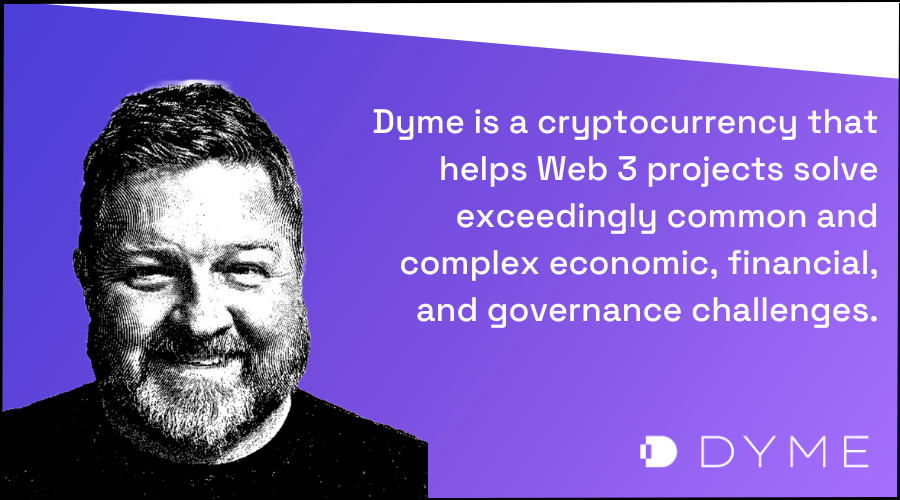
Dyme was developed to promote the adoption and growth of Web 3 by addressing these challenges. Dyme is part of the Cosmos Interchain, built on Ignite and using Cosmos SDK. We believe Dyme expands on the Cosmos “Internet of Blockchains” in a positive way by providing the economic models and exemplars of use for Web 3 projects and by offering a reserve cryptocurrency for those projects to use.
Dyme tackles the challenge in three main areas necessary for a decentralized but standardized economic structure: democratic governance, decentralized management, and transparent economic structures and goals.
In this Dyme Piece, we’ll look at Dyme’s governance structure to answer the question, “Is Dyme a DAO?”
What is a DAO?
The topic of decentralized autonomous organizations has received significant attention since the first decentralized blockchain was described by a person (or group of people) known as Satoshi Nakamoto in 2008. The blockchain design was implemented the following year by Nakamoto as a core component of the cryptocurrency Bitcoin.
Decentralization is an essential element of blockchain-based cryptocurrency. By storing data across the peer-to-peer network of the blockchain nodes, decentralization eliminates some risks that come with data being held centrally. We use a sovereign instance of the Ignite (formerly Tendermint) blockchain to create Dyme and Cosmos SDK to connect to the broader Internet of Blockchains.
Decentralization also enables a trustless transactional environment. Every node in a decentralized blockchain has a copy of the blockchain. No centralized “official” copy exists, and no user is “trusted” more than any other.
Before he founded Ethereum, Vitalik Buterin wrote about DAOs
In 2013, Ethereum co-founder Vitalik Buterin brought the phrase decentralized autonomous organizations to life. By 2018, the definition of a DAO and descriptions of how a DAO works centered on six major points:
- DAOs enable people to coordinate and self-govern themselves online. Although no mention is made as to the minimum size of the group, the term “organization” is generally understood to refer to an entity comprising multiple people acting towards a common goal rather than a legally registered organization.
- A DAO source code is deployed in a blockchain with smart contract capabilities like Ethereum—arguably always a public blockchain.
- A DAO’s smart contract code specifies the rules for interaction among people —although it is unclear to what extent other governance mechanisms may affect or overrule such code.
- Since these rules are defined using smart contracts, they are self-executed independently of the parties’ will.
- The DAO governance should remain independent from central control. Some definitions specifically refer to self-governed, self-organizing, peer-to-peer, and democratic control.
- Since they rely on a blockchain, DAOs inherit some properties from the blockchain, such as transparency, cryptographic security, and decentralization.
These will be the points we evaluate to answer our question about Dyme’s DAO status.
Is Dyme a Decentralized Autonomous Organization?
Since the author is a coder, the evaluation will be step-wise and hopefully not pedantic. While the technical specifications for Dyme have matured over the past year, Dyme is still in development. Dyme is expected to launch in late June 2023.
Seventeen web developers, UX designers, blockchain developers, and other experts have worked on Dyme for over six months. For this evaluation, we only list services we intend to launch in the June 2023 release.
We also distinguish between those features and future or speculative features.
DAOs enable people to coordinate and self-govern themselves online.
This is the broadest point to evaluate. Dyme operates online, using Discord and a browser-based wallet for governance and coordination services. These services allow for coordination and discussion in different ways.

Once launched, Dyme’s Discord server will provide verified Dyme members a place to interact. While anyone can view and read the governance channels, adding to the governance discussion is available only to verified Dyme wallet holders.
Similarly, Dyme’s browser-based wallet provides information about active proposals and the means to vote inside the wallet. The forms and information on the wallet are drawn from the Discord server, further aligning the governance process.
Thus, Dyme enables people to coordinate and self-govern themselves online.
A DAO source code is deployed in a public blockchain with smart contract capabilities.
Dyme uses a sovereign instance of the Ignite (formerly Tendermint) blockchain and Cosmos SDK to connect to the broader Internet of Blockchains. The smart contract capabilities of Tendermint are modular: they are “in-chain” instead of “on-chain.”
Dyme intends to use validators from the Cosmos community to be a public blockchain. We will publish Dyme’s tokenomics structure before launch.
Thus, Dyme’s source code is deployed on a public blockchain with smart contract capabilities.
A DAO’s smart contract code specifies the rules for interaction among people.
Dyme’s governance logic will be the subject of a forthcoming Dyme Piece, as it is central to Dyme’s thesis. Since we have not yet made this code public on the Dyme Github, we cannot yet claim success in this area.
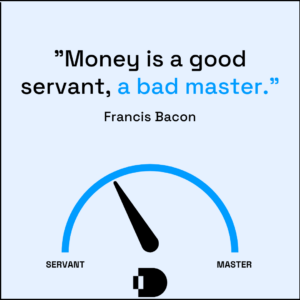
Dyme has worked to align the governance methods of the Foundation with governance in the DAO. This alignment goes further than the definition of “organization” in the first of the six points, directly linking the two and placing the DAO’s governance as the sole means of setting resolutions before the Foundation’s board.
We also address how the “other governance process” overrides the code of the DAO. If the Foundation cannot legally perform an act, this override serves as a final backstop against bad actors in the Dyme community. This override is expressly limited to those actions which are illegal.
Thus, Dyme’s smart contract code and governance documents specify the rules for interaction among people, but we cannot claim full credit until we publish the materials.
These rules are defined using smart contracts; they are self-executed independently of the parties’ will.
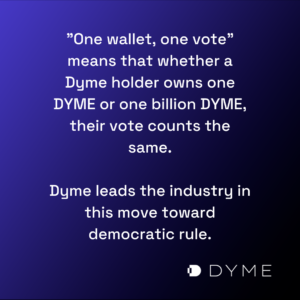
Dyme’s governance process is modeled on the Cosmos on-chain governance methods. As previously described, Dyme also has aligned the organization’s legal formation and management documents with the DAO code. DAO governance proposals are treated like board resolutions, and the only way to bring forward a board resolution is through the on-chain governance process.
This loop establishes that no licit organizational actions are taken outside of the DAO governance process and that only DAO governance proposals that are passed by the vote of the DAO advance to the board for action.
The process of executing “the will of the DAO” is an area of some debate in the community. Positions range from absolute autonomy and automation of the DAO to decentralization only at the infrastructural layer.
Dyme takes the position that DAO governance must not bend to the whims of a small group of actors but should operate with the participation of its members and outside organizations as directed by the DAO. This is the most complex solution to put in place since it requires the alignment of both software code and government and regulatory documents.
An important element of Dyme, and one which is divergent from Cosmos code, is Dyme’s governance concept of “one wallet, one vote.” This will be the subject of a future Dyme Piece. It means effectively that whether a Dyme holder owns one DYME or one billion DYME, their vote counts the same. Dyme leads the industry in this move toward democratic rule.
Thus, the Dyme DAO rules are defined using smart contracts, they are self-executed independently of the parties’ will, and they comport with corporate law.
The DAO governance should remain independent from central control.
Dyme has no CEO. The ultimate beneficial owner of BVI-based Dyme, Ltd. is the Cayman Islands-based DYME Foundation, a memberless foundation. As a board of directors governs all legal entities, the Dyme DAO appointed a sole director.
The Dyme Foundation organization documents provide one path for a proposal to reach the board for action: the DAO proposal process. The board of directors is structurally prohibited from acting outside the Dyme DAO proposal process. The directors cannot and should not authorize any illegal activity and thus serve as a final backstop against bad actors in the Dyme community.
Thus, Dyme is independent of central control and comports with the requirements of legal propriety.
DAOs inherit some properties from the blockchain.
This evaluation point feels a bit like guaranteed extra credit. Dyme’s native cryptocurrency provides no ownership rights in Dyme. It does offer governance rights, and from that, the Dyme DAO inherits the properties of the Dyme blockchain.
As Dyme’s cryptocurrency is the Dyme governance token, there is a strong alignment of interest among Dyme holders to increase the value of Dyme.
Closing
Dyme is a DAO.
To amplify a few key points from this article: Dyme’s governance is not run by a small group of actors. It is managed by software code placed on a public blockchain. The legal structure of the organization is aligned with the DAO’s smart contracts. Dyme’s “one wallet, one vote” voting structure is strongly democratic.
